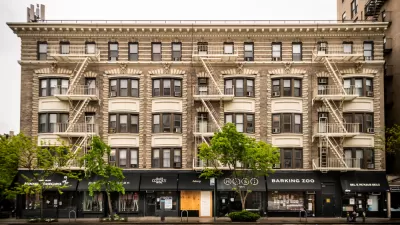The city is experiencing significant growth and development, but it has a complicated history of booms and lags and its civic future is uncertain.

Mitchell Schwarzer takes a closer look at the development history of Oakland, California, through its various booms—starting in the 1920s, then in the 1960s and 2010s, and now reflected in the current construction flurry in downtown Oakland.
While he welcomes the density and vibrancy that will come with the many new residential, hotel, and office buildings, Schwarzer argues that important aspects of the city, as well as its vulnerable residents, are being ignored by civic leaders. "Expanded rail and bus networks, education systems, parks, and civic buildings — active ingredients in earlier times of city-making — are largely absent. The myriad interrelated functions that maintain a public city are being neglected."
Schwarzer grapples with this conflict between Oakland’s new outlook, after periods of neglect when other cities like San Francisco and Berkeley reoriented themselves and flourished, and the rapidly growing problems with homelessness, poverty, and an extreme lack of affordable housing.
These new pricey rentals and condos, to a certain degree, make older housing more available, as they have in the past, he notes. "But it is increasingly common to hear longtime residents voice nostalgia for the days when Oakland was bypassed by global capital flows, when downtown was a dead zone in the dark hours, and cranes were seen only at the Port — when the all-too-gritty reality of the Town kept investors away."
Schwarzer concludes by saying that a plan for affordable housing and a commitment to public investment must be top priorities. He also urges residents who want to live in a modern-day city like Oakland to wake up to the realities:
Most folks oppose suburban sprawl into wild lands and farms. Most enjoy vital urban centers, and understand the need for affordable housing. Most celebrate class and ethnic diversity. Yet the NIMBY attitude spawned in the era of overreaching public projects remains powerful. It is simply not possible to have it both ways, attaining cosmopolitan complexity while enjoying what amounts to a suburban-style life.
The San Francisco Bay Area has experienced astounding economic growth, says Schwarzer, and he wants cities like Oakland to affirm the public city—one that is dense, equitable, and focused on the needs of all residents—rather than supporting privatization and economic and social exclusion.
FULL STORY: Privatizing the Public City

Alabama: Trump Terminates Settlements for Black Communities Harmed By Raw Sewage
Trump deemed the landmark civil rights agreement “illegal DEI and environmental justice policy.”

Study: Maui’s Plan to Convert Vacation Rentals to Long-Term Housing Could Cause Nearly $1 Billion Economic Loss
The plan would reduce visitor accommodation by 25% resulting in 1,900 jobs lost.

Planetizen Federal Action Tracker
A weekly monitor of how Trump’s orders and actions are impacting planners and planning in America.

Wind Energy on the Rise Despite Federal Policy Reversal
The Trump administration is revoking federal support for renewable energy, but demand for new projects continues unabated.

Passengers Flock to Caltrain After Electrification
The new electric trains are running faster and more reliably, leading to strong ridership growth on the Bay Area rail system.

Texas Churches Rally Behind ‘Yes in God’s Back Yard’ Legislation
Religious leaders want the state to reduce zoning regulations to streamline leasing church-owned land to housing developers.
Urban Design for Planners 1: Software Tools
This six-course series explores essential urban design concepts using open source software and equips planners with the tools they need to participate fully in the urban design process.
Planning for Universal Design
Learn the tools for implementing Universal Design in planning regulations.
Caltrans
Smith Gee Studio
Institute for Housing and Urban Development Studies (IHS)
City of Grandview
Harvard GSD Executive Education
Toledo-Lucas County Plan Commissions
Salt Lake City
NYU Wagner Graduate School of Public Service





























